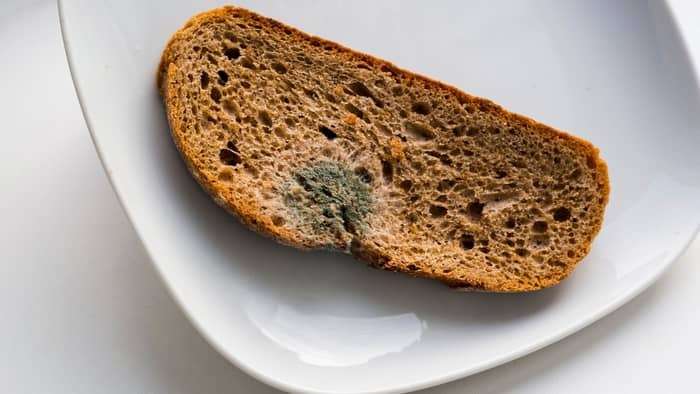Last Updated on April 23, 2022
Unfortunately, bread can grow mold even if you are carefully storing it. When this happens, toasting moldy bread may seem like a practical option. However, mold is something you want to always avoid as it can make you ill.
Both homemade and store-bought bread can go moldy within a week or two, even with proper storage. Typically, store-bought bread can last around a week longer than homemade bread. Though moldy bread can happen in any house, it is more prone to grow in warm, damp environments.
Can You Eat Moldy Bread?
Mold can grow on bread because bread contains moisture and is stored at room temperature. In addition, its soft and porous consistency makes it easy for mold to grow. It can become a breeding ground for mold, especially in warm, humid climates.
When mold grows on bread, it is generally white with spots of green or blue. It typically has a fuzzy texture along with an unpleasant smell too. Spores on your bread can quickly spread and even spread to other foods around it as well.
Unfortunately, you can not eat moldy bread. Not only does it tastes bad and has a gross texture, it can also potentially make you sick. If you notice there is any mold on your bread, then don’t eat it.
Though you may be fine if you eat moldy bread, it can cause nausea or vomiting. In more serious cases, people may have adverse reactions that require medical attention, though this is rare.

Is toasting moldy bread safe?
Some people think that toasting moldy bread can be safe to eat since the bread gets heated. However, the heat from the toaster does not kill the mold in the bread.
Not only will the bread still have mold on it after toasting, but it will also taste bad too. Since bread is so porous, the mold will be deep in the bread. To successfully kill the mold off the bread, the bread would no longer be edible. Unfortunately, toasting moldy bread is not safe and it will not get rid of the mold on the bread.
What to do with moldy bread
Unfortunately, if you have moldy bread the only thing you can do with it is to throw it out. It is not worth eating the bread, as the risks that come with mold are not worth it. In addition, it won’t taste or smell good either.
Even if your bread only has a small patch of mold, you can’t just cut out the moldy spot. The entire loaf is at risk of containing mold even if you can’t see all of it.
The roots of the mold often go deeper than what you can see, which is why you can’t just cut off the area where the mold is. Even if you remove the area where there is visible mold, there are likely still mold spores in the bread that could potentially make you sick.
How To Properly Store Bread To Prevent Mold
Though mold can grow on bread, there are ways to properly store it to reduce the chance of mold growth. With the proper storage, you can help keep your bread fresh for longer.
Before storing, allow your bread to fully cool. Then, store it in a bread box, plastic wrap, Ziploc bag, or airtight container. Most homemade bread will last for around two to three days at room temperature.
Storebought bread can last for around one week, sometimes up to two weeks, at room temperature. You should store your bread in a cool, dry area that is not humid or warm. Even if in a proper container, bread can manage to grow mold in warm, humid environments.
Generally, you don’t want to store your bread in the fridge, as it can cause it to dry out faster. However, if you live somewhere that is particularly warm or humid, storing your bread in the fridge can be a good option. The temperature of the fridge is too cold for mold to grow.
Freezing bread
Fortunately, if you can’t eat your bread quick enough before it goes bad, you can freeze it. Bread freezes well and can last for up to six months in the freezer.
1 Roll Microwave-Safe Cling Film – With Removable Slide-Cutter, BPA-Free, – Restaurantware
To freeze bread, allow it to fully cool and then wrap it in a layer of plastic wrap or aluminum foil. You can also place it in a Ziploc bag to freeze too. For store-bought bread, you can just freeze it in the plastic bag it comes in.
When you are ready to eat your frozen bread, let it thaw in the fridge overnight or on the counter for around thirty minutes to two hours. You can also warm the bread up in the microwave for a few seconds or in the oven for a few minutes.
Throwing Out Moldy Bread
Unfortunately, you can’t toast moldy bread and eat it, as toasting it is not enough to kill the mold. In fact, if your bread has any mold on it you should throw it out as mold can potentially make you sick. The roots of mold can go far beyond the visible spots you see, which is why you simply can’t just get rid of the mold spots.
Do you have any questions regarding toasting moldy bread? If so, please ask any questions regarding bread and proper storage in the comments.
FAQs
Does Toasting Kill Mold on Bread?
Unfortunately, toasting bread does not actually kill mold. The heat from the toaster is not enough to kill the mold on the bread.
Is Toasted Moldy Bread Safe?
Bread that has mold on it is not safe to eat even if it was toasted on it. A toaster does not kill the mold, so the bread is not safe to eat.
What Happens if You Eat Moldy Toast?
In most cases, you will likely be fine if you eat moldy toast but you may experience nausea or vomiting. In severe cases, some people might experience allergic reactions to the mold and need medical attention.

Ever since she was a young girl, Anna has been a lover of desserts. As an adult, she enjoys
baking a variety of desserts from cakes, cookies, brownies, bread, and more from scratch. She
enjoys sharing her passion for baking with others who also have a sweet tooth. From properly
measuring ingredients to making sure they are the correct temperature, Anna knows the
importance small details can make in baking. She wants to share her experience with others in
hopes they can make the most delicious baked goods. When she’s not busy blogging, Anna
enjoys trying new recipes in the kitchen.


